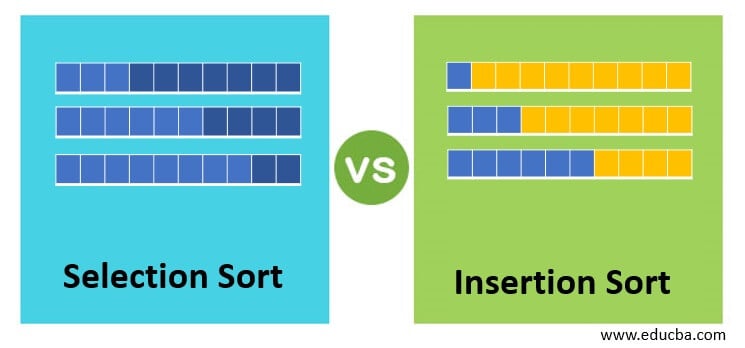Updated April 10, 2023
Introduction to Selection Sort vs Insertion Sort
This article focuses on selection sort and insertion sort along with their differences. Selection sort is a way of sorting in which the items of an array are sorted by repeatedly identifying the minimum element in ascending order is considered from the unsorted part and puts it in the beginning. There are two subarrays maintained in this process, one which is already sorted and another one which is to be sorted. Whereas, insertion sort is a simple technique for sorting in which the array is split into two parts, sorted and unsorted. Then from the unsorted pack, the values are selected and put in the sorted pack.
Head to Head Comparison Between Selection Sort vs Insertion Sort(Infographics)
Below are the top 9 differences between Selection Sort vs Insertion Sort:
Comparison Table of Selection Sort vs Insertion Sort
|
Selection Sort Insertion Sort |
Insertion Sort |
|
|
|
|
|
|
|
|
|
|
|
|
|
|
|
|
|
|
Key differences between Insertion Sort and Selection Sort
Sorting can be defined as a process of systematically arranging the items. This includes ordering as well as arranging the items of a list in a sequenced order according to the criteria specified. Categorizing or grouping of items can also be done through sorting.
Insertion sorting:
Insertion sorting is a way of sorting elements of an array where a set of values are inserted in the existing sorted file. A single element is inserted at a time to the sorted array in insertion sorting. This process goes on till the complete array gets sorted in the desired order. The basic concept followed by insertion sorting is that it inserts each and every item individually to its appropriate place in the sorted list. An effective amount of memory is saved by using insertion sort. The major advantages of insertion sort are:
The implementation of insertion sort is very easy and highly efficient if it is used with a small set of data. The requirement of additional memory space is very less in the process of insertion sorting. Insertion sorting is also considered a live sorting technique as it can also deal with immediately added data in the array.
Insertion sorting is considered a faster option to sort data if compared to its other counterparts.
Working of the Insertion sort is explained as follows:
Two sets of an array is used in insertion sorting in which one set contains the unsorted elements and another one contains the sorted elements. The algorithm of sorting elements using insertion sorting runs till the last element of the unsorted set. If an array contains ‘n’ number of elements then the 0th element is in the sorted set and the remaining elements are in the unsorted set.
Array index 1 is defined as the first element of the unsorted set of the array. After every iteration, the first element of the unsorted set is chosen and inserted in its appropriate place in the sorted set.
Selection sorting:
In selection sorting, the array of the elements is divided into two sets, one for the unsorted part and another one for the sorted part of the array. Selection sorting is a way of sorting in which the algorithm searches for the minimum value in the elements of the array and places it in the first or last position depending on the sorting criteria, to the sorted set. The search for the minimum value amongst the elements is done till the last element of the unsorted set of the array and until all the elements get placed in their appropriate place.
Working of the Selection Sort is explained as follows:
If an array contains ‘n’ elements in the memory. Then, in the first step, the element with the smallest value is searched and it is swapped with its position with the element which was in the first position previously.
After this, again the smallest element is searched and swapped with the element previously present in the second position. In the n-1th step, the same process is completed for sorting the n number of elements.
Conclusion
On the basis of the above article, we understood the concept of sorting and the differences between the two ways of sorting i.e insertion sort and selection sort. This article explains the major differences between insertion sort and selection sort which will help the readers in selecting the way of sorting according to their requirements.
Recommended Articles
This is a guide to Selection Sort vs Insertion Sort. Here we discuss the definition, Head to Head Comparison Between Selection Sort vs Insertion Sort with infographics. You may also have a look at the following articles to learn more –




